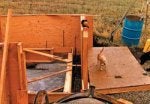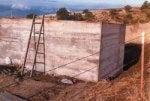Good evening, everyone. My name is Doug and I am new to the site, as well as this style of messaging. I am relatively new to the prepper community but recognize the very real advantages preparedness affords and have committed to building a bunker for myself and family in 2016. I got into prepping purely by accident. I ordered a book on fatherhood best practices a few months back and Amazon accidentally shipped me a book called One Second After. They let me keep it because the mix up was theirs and I found it to be very compelling.
I am an army veteran; work as a software project manager; and have a wife of eight years and three children (and counting). We rent in Newcastle, WA now but will make a move east to the Snoqualmie area to settle on a home (at the base of the Cascade Mountain range) with a few acres in the next six months.
I have a bunker budget of $150k and have had many conversations with a highly regarded concrete contractor who has quoted me $75k (minus excavation) for a 20'x60' reinforced concrete bunker with 8' ceilings, 8" walls, and the roof at 5' below ground (entryway included). I have included as attachments here a footprint and rough schematic of the power, water, ventilation, and drainage infrastructure.
Power - In the event of an EMP/solar storm the wiring and solar panels will be stored in one of the bunker's bedrooms. The physical hookups will be put on my roof right away, oriented in such a way as to maximize sun exposure. When needed, the panels and wiring will be brought out, hooked up, and will feed into the bunker's battery system, feeding the LED lights, water heater, and ventilation fans (NBC filtration system). Does anyone have any guidance on lessons learned or advice on what the "best" solar panel/battery system might be for my needs? No refrigeration or anything substantial. The bunker will not be fed by any power system besides this solar panel and battery setup.
Ventilation - There will be steel ventilation pipes every 10' (so 14 total, standing about 8' tall on the surface, each with holes drilled throughout the sides of the top) along the sides that serve the dual purposes of concealed ventilation inlets and chain link fence posts (probably supplemented by smaller posts in the middle, every 5'). The fence would encircle a garden and fruit trees, and the enclosure would further be surrounded by orchard. These will feed along the ceiling of the bunker into a central pipe that feeds into an NBC filtration system with capacity for up to 17 or so people. As with the power section above, any guidance in this area will be especially appreciated.
Water - I am thinking of burying an adjacent 20,000 gallon fiberglass potable water storage tank, gravity-fed into bunker kitchen and restroom. Roof runoff (hopefully I can get a metal or clay roof) could be fairly easily channeled into a buried receiver pipe that would store the plentiful water we get in the Pacific Northwest. This would be buried just under the service for both ease of accessibility to the top and to take advantage of gravity to feed into the kitchen and restroom. What are your thoughts on this idea and its potential for safe, long-term storage? A water heater would be one of the few draws on the solar panels/batteries, so water would have to go through this system for the kitchen sink and shower. Would anything need to be added to the water to increase its longer term viability? Drainage options also need to be considered. Any advice is most welcome.
Drainage - For grey water I am thinking of a pipe that would ideally (again) gravity feed into vegetation of some sort. And as far as septic, I was (perhaps naively) hoping to avoid that altogether with a very nice compost toilet. I just worry about the maintenance involved with a septic system - am I wrong? I might well be. The thinking is that the composted waste would be recycled above in the garden and orchard. The only requirement would be a vent pipe leading to the surface.
At the end of the day, I just want this to be concealed entirely (entrance under a carpet in a well-locked inconspicuous garden shed). So if anyone walked in my back yard they'd just see a garden with a bunch of fruit trees. And even if SHTF, the only change from normal would be the presence of solar panels atop the roof with a well-hidden/buried cable leading to the shed and the rain gutter pipe feeding into a pipe in the ground. The storage room would of course be stocked with 2,000 or so 50 oz. cans of Ma Collis (Keystone) beef and chicken, with enough rice, lentils, salt, beans, and wheat to feed a small army.
I feel in good company with you all and have to say it is nice to be able to talk about this stuff without getting sideways looks. I just can't stand the thought of my little ones facing the sort of conditions one might expect if the grid goes down even for a month or two.
Thanks for your insight and recommendations on where I should go to procure these items or what I should be considering as I move forward with this investment. I look forward to many years with you all. I will also pose the same questions to the electricity and other chats in this community.
Best,
Doug
I am an army veteran; work as a software project manager; and have a wife of eight years and three children (and counting). We rent in Newcastle, WA now but will make a move east to the Snoqualmie area to settle on a home (at the base of the Cascade Mountain range) with a few acres in the next six months.
I have a bunker budget of $150k and have had many conversations with a highly regarded concrete contractor who has quoted me $75k (minus excavation) for a 20'x60' reinforced concrete bunker with 8' ceilings, 8" walls, and the roof at 5' below ground (entryway included). I have included as attachments here a footprint and rough schematic of the power, water, ventilation, and drainage infrastructure.
Power - In the event of an EMP/solar storm the wiring and solar panels will be stored in one of the bunker's bedrooms. The physical hookups will be put on my roof right away, oriented in such a way as to maximize sun exposure. When needed, the panels and wiring will be brought out, hooked up, and will feed into the bunker's battery system, feeding the LED lights, water heater, and ventilation fans (NBC filtration system). Does anyone have any guidance on lessons learned or advice on what the "best" solar panel/battery system might be for my needs? No refrigeration or anything substantial. The bunker will not be fed by any power system besides this solar panel and battery setup.
Ventilation - There will be steel ventilation pipes every 10' (so 14 total, standing about 8' tall on the surface, each with holes drilled throughout the sides of the top) along the sides that serve the dual purposes of concealed ventilation inlets and chain link fence posts (probably supplemented by smaller posts in the middle, every 5'). The fence would encircle a garden and fruit trees, and the enclosure would further be surrounded by orchard. These will feed along the ceiling of the bunker into a central pipe that feeds into an NBC filtration system with capacity for up to 17 or so people. As with the power section above, any guidance in this area will be especially appreciated.
Water - I am thinking of burying an adjacent 20,000 gallon fiberglass potable water storage tank, gravity-fed into bunker kitchen and restroom. Roof runoff (hopefully I can get a metal or clay roof) could be fairly easily channeled into a buried receiver pipe that would store the plentiful water we get in the Pacific Northwest. This would be buried just under the service for both ease of accessibility to the top and to take advantage of gravity to feed into the kitchen and restroom. What are your thoughts on this idea and its potential for safe, long-term storage? A water heater would be one of the few draws on the solar panels/batteries, so water would have to go through this system for the kitchen sink and shower. Would anything need to be added to the water to increase its longer term viability? Drainage options also need to be considered. Any advice is most welcome.
Drainage - For grey water I am thinking of a pipe that would ideally (again) gravity feed into vegetation of some sort. And as far as septic, I was (perhaps naively) hoping to avoid that altogether with a very nice compost toilet. I just worry about the maintenance involved with a septic system - am I wrong? I might well be. The thinking is that the composted waste would be recycled above in the garden and orchard. The only requirement would be a vent pipe leading to the surface.
At the end of the day, I just want this to be concealed entirely (entrance under a carpet in a well-locked inconspicuous garden shed). So if anyone walked in my back yard they'd just see a garden with a bunch of fruit trees. And even if SHTF, the only change from normal would be the presence of solar panels atop the roof with a well-hidden/buried cable leading to the shed and the rain gutter pipe feeding into a pipe in the ground. The storage room would of course be stocked with 2,000 or so 50 oz. cans of Ma Collis (Keystone) beef and chicken, with enough rice, lentils, salt, beans, and wheat to feed a small army.
I feel in good company with you all and have to say it is nice to be able to talk about this stuff without getting sideways looks. I just can't stand the thought of my little ones facing the sort of conditions one might expect if the grid goes down even for a month or two.
Thanks for your insight and recommendations on where I should go to procure these items or what I should be considering as I move forward with this investment. I look forward to many years with you all. I will also pose the same questions to the electricity and other chats in this community.
Best,
Doug
















